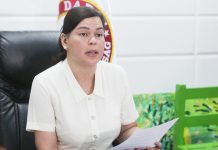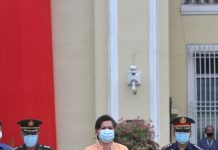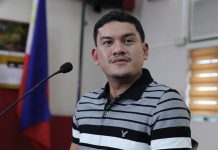The Department of Social Welfare and Development launched last October 14 the survey results of the National Household Targeting System for Poverty Reduction (NHTS-PR) at the Grand Regal Hotel in Davao City.
“We held the regional launch in time for the observance of the 22nd National Statistics Month with the theme, Quality Social Protection Statistics for Focused Targeting: Improving Outcomes, Changing Lives. The national launch of the survey was held October 3 at Century Park Hotel, Manila,” said DSWD director Ester A. Versoza.
Keynote speaker for the regional launch was Undersecretary Alicia R. Bala of DSWD who signed a memorandum of agreement with Mayor Sara Z. Duterte and other local chief executives in the region, on the utilization of the survey results, Versoza said.
“With this database, we hope to encourage as many users as possible so that more basic needs of program beneficiaries will be addressed and more deserving poor are able to access appropriate and timely interventions, not only from the government but also from non-government groups,” Versoza emphasized.
Among those present were chair of the Regional Statistical Coordination Committee of the Regional Development Council and NEDA 11 director Ma. Lourdes D. Lim and National Statistical Coordination Board regional head Estrella R. Turingan.
Implemented by DSWD, NHTS-PR is a data management system that makes available a database of poor households as reference in identifying beneficiaries of social protection services.
It aims to come up with a functional, objective and transparent targeting system that identifies who and where the poor are, thus reducing leakage of social services to non-poor and minimizing exclusion of the poor from said social services.
The NHTS-PR database serves as guide for national government agencies and other stakeholders in identifying qualified beneficiaries of their social protection programs.
The NHTS-PR Advisory Group is composed of experts from the NSCB, NSO, NEDA, UP, ADMU and the Phil. Institute for Development Studies.
Institutionalized in 2009, the NHTS-PR has assessed 10,909,456 households and was able to identify 5,255,118 poor households nationwide.
Meanwhile, DSWD 11 was able to enumerate a total of 547,775 households and out of this figure, 272,933 were identified as poor and eligible for various social protection programs of the government and non-government groups.
Generated data include family size, educational attainment, access to health center, toilet facilities, electricity, water source, roof materials, and prevalence of displacement, disability, senior citizens and solo parents.
The data are the basis for classification of households into Food Poor (families whose income is below the food threshold level, i.e. not able to meet their basic food requirements); Survival Poor (those in between the food and poverty threshold, i.e. able to meet their food but not the other basic requirements); and Non-Poor (families living above the poverty threshold and able to meet their basic requirements).
DSWD’s Pantawid Pamilyang Pilipino Program and Social Pension for Indigent Senior Citizens are both using NHTS-PR data in identifying beneficiaries. Earlier, PhilHealth and the Department of Health (DOH) also entered into a memorandum of agreement (MOA) with DSWD on the use of NHTS-PR data in the implementation of their respective social protection programs. [DSWD-11/NHTS-PR/Carmela Cadigal-Duron]
“We held the regional launch in time for the observance of the 22nd National Statistics Month with the theme, Quality Social Protection Statistics for Focused Targeting: Improving Outcomes, Changing Lives. The national launch of the survey was held October 3 at Century Park Hotel, Manila,” said DSWD director Ester A. Versoza.
Keynote speaker for the regional launch was Undersecretary Alicia R. Bala of DSWD who signed a memorandum of agreement with Mayor Sara Z. Duterte and other local chief executives in the region, on the utilization of the survey results, Versoza said.
“With this database, we hope to encourage as many users as possible so that more basic needs of program beneficiaries will be addressed and more deserving poor are able to access appropriate and timely interventions, not only from the government but also from non-government groups,” Versoza emphasized.
Among those present were chair of the Regional Statistical Coordination Committee of the Regional Development Council and NEDA 11 director Ma. Lourdes D. Lim and National Statistical Coordination Board regional head Estrella R. Turingan.
Implemented by DSWD, NHTS-PR is a data management system that makes available a database of poor households as reference in identifying beneficiaries of social protection services.
It aims to come up with a functional, objective and transparent targeting system that identifies who and where the poor are, thus reducing leakage of social services to non-poor and minimizing exclusion of the poor from said social services.
The NHTS-PR database serves as guide for national government agencies and other stakeholders in identifying qualified beneficiaries of their social protection programs.
The NHTS-PR Advisory Group is composed of experts from the NSCB, NSO, NEDA, UP, ADMU and the Phil. Institute for Development Studies.
Institutionalized in 2009, the NHTS-PR has assessed 10,909,456 households and was able to identify 5,255,118 poor households nationwide.
Meanwhile, DSWD 11 was able to enumerate a total of 547,775 households and out of this figure, 272,933 were identified as poor and eligible for various social protection programs of the government and non-government groups.
Generated data include family size, educational attainment, access to health center, toilet facilities, electricity, water source, roof materials, and prevalence of displacement, disability, senior citizens and solo parents.
The data are the basis for classification of households into Food Poor (families whose income is below the food threshold level, i.e. not able to meet their basic food requirements); Survival Poor (those in between the food and poverty threshold, i.e. able to meet their food but not the other basic requirements); and Non-Poor (families living above the poverty threshold and able to meet their basic requirements).
DSWD’s Pantawid Pamilyang Pilipino Program and Social Pension for Indigent Senior Citizens are both using NHTS-PR data in identifying beneficiaries. Earlier, PhilHealth and the Department of Health (DOH) also entered into a memorandum of agreement (MOA) with DSWD on the use of NHTS-PR data in the implementation of their respective social protection programs. [DSWD-11/NHTS-PR/Carmela Cadigal-Duron]






